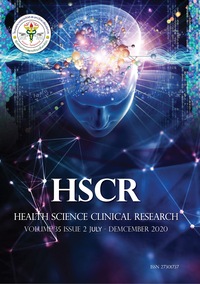ปัจจัยเสี่ยงที่มีความสัมพันธ์กับการปัสสาวะไม่ออกเฉียบพลัน ในผู้ป่วยต่อมลูกหมากโต ในโรงพยาบาลหนองคาย
คำสำคัญ:
ต่อมลูกหมากโต, ปัสสาวะไม่ออกเฉียบพลัน, ปัจจัยเสี่ยงบทคัดย่อ
วัตถุประสงค์ : เพื่อศึกษาปัจจัยที่มีความสัมพันธ์กับการเกิดภาวะปัสสาวะไม่ออกเฉียบพลันในผู้ป่วยต่อมลูกหมากโตใน
โรงพยาบาลหนองคาย
วิธีการศึกษา : เป็นการศึกษาย้อนหลังแบบมีกลุ่มควบคุม โดยเก็บข้อมูลจากเวชระเบียนผู้ป่วยและบันทึกในโปรแกรม HOSxP
ของผู้ป่วยต่อมลูกหมากโต ที่มารับบริการที่แผนกผู้ป่วยนอกและแผนกอุบัติเหตุและฉุกเฉินในโรงพยาบาลหนองคาย ช่วงเวลา
ตั้งแต่ 1 มกราคม 2560 ถึง 31 ธันวาคม 2562 โดยแบ่งเป็น 2 กลุ่มได้แก่ กลุ่มควบคุมคือ กลุ่มที่ปัสสาวะออกได้ (control)
และกลุ่มที่ปัสสาวะไม่ออกเฉียบพลัน (case) นำมาวิเคราะห์หาปัจจัยเสี่ยงด้านอายุ ดัชนีมวลกาย โรคประจำตัว ค่า PSA
ภาวะท้องผูกติดเชื้อทางเดินปัสสาวะส่วนล่าง ปัสสาวะเป็นเลือดประวัติการปัสสาวะไม่ออกมาก่อน และการได้รับยากลุ่ม
anticholinergic โดยใช้สถิติเชิงวิเคราะห์ Pearson chi-square คำนวณหาค่าความเสี่ยงสัมพัทธ์จากการวิเคราะห์ตัวแปร
เดี่ยว (univariate analysis) และวิเคราะห์ถดถอยพหุลอจิสติค (logistic regression analysis) ที่ระดับความเชื่อมั่นร้อยละ 95
ผลการศึกษา : ผู้ป่วยที่เข้าเกณฑ์การศึกษาทั้งหมด 693 ราย แบ่งเป็นกลุ่มที่ปัสสาวะออกได้จำนวน 653 ราย และกลุ่มที่ปัสสาวะ
ไม่ออกเฉียบพลันจำนวน 40 รายอุบัติการณ์การปัสสาวะไม่ออกเฉียบพลันในการศึกษานี้ 19.24 คนต่อ 1000 ประชากรผู้ป่วย
ต่อมลูกหมากโตต่อปี จากการวิเคราะห์สถิติหาความเสี่ยงสัมพัทธ์ตัวแปรเดี่ยว พบว่าปัจจัยเสี่ยงที่มีความสัมพันธ์กับการปัสสาวะ
ไม่ออกเฉียบพลันในผู้ป่วยต่อมลูกหมากโต พบว่ามี 4 ปัจจัย ได้แก่ มีประวัติปัสสาวะไม่ออกมาก่อน ค่า PSA ที่มากกว่า 4 มี
การติดเชื้อติดเชื้อทางเดินปัสสาวะส่วนล่าง และอายุที่มากกว่า 72 ปี เมื่อทำการวิเคราะห์ตัวแปรแบบถดถอยพหุลอจิสติคพบว่า
มี 3 ปัจจัยที่มีความสัมพันธ์กับการปัสสาวะไม่ออกเฉียบพลันได้แก่ มีประวัติปัสสาวะไม่ออกมาก่อน มีการติดเชื้อติดเชื้อทางเดิน
ปัสสาวะส่วนล่าง และค่า PSA ที่มากกว่า 4 โดยมีความเสี่ยงเท่ากับ 5.565, 3.732 และ 3.636 เท่า ตามลำดับ
สรุปและข้อเสนอแนะ : ปัจจัยเสี่ยงที่มีความสัมพันธ์กับการปัสสาวะไม่ออกเฉียบพลันในผู้ป่วยต่อมลูกหมากโตได้แก่ ประวัติ
ปัสสาวะไม่ออกมาก่อน ค่า PSA ที่มากกว่า 4 และมีการติดเชื้อติดเชื้อทางเดินปัสสาวะส่วนล่าง ปัจจัยเสี่ยงที่ได้จากการศึกษา
จะช่วยทำนายโอกาสการเกิดปัสสาวะไม่อออกและช่วยวางแผนการรักษาที่เหมาะสมสำหรับผู้ป่วย
คำสำคัญ : ต่อมลูกหมากโต, ปัสสาวะไม่ออกเฉียบพลัน, ปัจจัยเสี่ยง
เอกสารอ้างอิง
Study Group. Management of acute urinary retention: a worldwide survey of 6074 men with benign
prostatic hyperplasia. BJU Int. 2012 Jan;109(1):88-95. doi: 10.1111/j.1464-410X.2011.10430.x. Epub2011 Nov
25. PMID: 22117624; PMCID: PMC3272343
2. Muruganandham K, Dubey D, Kapoor R. Acute urinary retention in benign prostatic hyperplasia: Risk factors
and current management. Indian J Urol. 2007 Oct;23(4):347-53. doi: 10.4103/0970-1591.35050. PMID:
19718286; PMCID: PMC2721562.
3. Addepalli, Jagadeeswar& S, Balasubramanya& Francis, John &Thanneru, Karthik. (2019). A study on acute
urinary retention in patients with benign prostatic hyperplasia at a rural setup. International Surgery Journal.
6. 1772. 10.18203/2349-2902.isj20191905.
4. Mahakalkar, Chandrashekhar & Prasad, Ayushree & Kaple, Meghali & Jain, Niket & Khadatkar, Aniket & Jai
puria, Parag. (2016). Predictors of urinary retention in benign prostate hyperplasia. International Journal of
Research in Medical Sciences. 486-490. 10.18203/2320-6012.ijrms20160301.
5. Kim, E.D. The use of baseline clinical measures to predict those at risk for progression of benign prostatic
hyperplasia. CurrUrol Rep 5, 267–273 (2004). https://doi.org/10.1007/s11934-004-0049-z
6. Fong YK, Milani S, Djavan B. Natural history and clinical predictors of clinical progression in benign prostatic
hyperplasia. CurrOpinUrol. 2005 Jan;15(1):35-8. doi: 10.1097/00042307-200501000-00009. PMID: 15586028.
7. SiavashFalahatkar, Ali HamidiMadani, Ahmad Enshaei, Ehsan Kazemnejad, SeyedehSamaneh Ahmadi, Keivan
GholamjaniMoghaddam, AliakbarAllahkhah.Risk Factors for Acute Urinary Retention in Patients With
Benign Prostatic Hyperplasia From the Islamic Republic of Iran.UroTodayInt J. 2010 Dec;3(6). doi:10.3834
/uij.1944-5784.2010.12.15
8. Thomas K, Chow K, Kirby RS. Acute urinary retention: a review of the aetiology and management. Prostate
Cancer Prostatic Dis. 2004;7(1):32-7. doi: 10.1038/sj.pcan.4500700. PMID: 14999235.
9. Muruganandham K, Dubey D, Kapoor R. Acute urinary retention in benign prostatic hyperplasia: Risk factors
and current management. Indian J Urol. 2007 Oct;23(4):347-53. doi: 10.4103/0970-1591.35050. PMID:
19718286; PMCID: PMC2721562.
10. Verhamme KM, Sturkenboom MC, Stricker BH, Bosch R. Drug-induced urinary retention: incidence,
management and prevention. Drug Saf. 2008;31(5):373-88. doi: 10.2165/00002018-200831050-00002. PMID:
18422378.
11. Vela-Navarrete R, Gonzalez-Enguita C, Garcia-Cardoso JV, Manzarbeitia F, Sarasa-Corral JL, Granizo JJ.
The impact of medical therapy on surgery for benign prostatic hyperplasia: a study comparing changes in
a decade (1992-2002). BJU Int. 2005 Nov;96(7):1045-8. doi: 10.1111/j.1464-410X.2005.05735.x. PMID: 16225526.
12. McConnell JD, Bruskewitz R, Walsh P, Andriole G, Lieber M, Holtgrewe HL, Albertsen P, Roehrborn CG,
Nickel JC, Wang DZ, Taylor AM, Waldstreicher J. The effect of finasteride on the risk of acute urinary
retention and the need for surgical treatment among men with benign prostatic hyperplasia. Finasteride
Long-Term Efficacy and Safety Study Group. N Engl J Med. 1998 Feb 26;338(9):557-63. doi:10.1056/
NEJM199802263380901. PMID: 9475762.
13. Andersen JT, Nickel JC, Marshall VR, Schulman CC, Boyle P. Finasteride significantly reduces acute urinary
retention and need for surgery in patients with symptomatic benign prostatic hyperplasia. Urology. 1997
Jun;49(6):839-45. doi: 10.1016/s0090-4295(97)00185-4. PMID: 9187688.
14. Patel PM, Sweigert SE, Nelson M, Gupta G, Baker M, Weaver FM, McVary KT. Disparities in Benign Prostatic
Hyperplasia Progression: Predictors of Presentation to the Emergency Department in Urinary Retention. J
Urol. 2020 Aug;204(2):332-336. doi: 10.1097/JU.0000000000000787. Epub2020 Jan 28. PMID: 31990248.
15. Roehrborn CG. BPH progression: concept and key learning from MTOPS, ALTESS, COMBAT, and ALF-ONE.
BJU Int. 2008 Mar;101Suppl3:17-21. doi: 10.1111/j.1464-410X.2008.07497.x. PMID: 18307681.
16. Emberton M, Lukacs B, Matzkin H, Alcaraz A, Elhilali M, Vallancien G. Response to daily 10 mg alfuzosin
predicts acute urinary retention and benign prostatic hyperplasia related surgery in men with lower urinary
tract symptoms. J Urol. 2006 Sep;176(3):1051-6. doi: 10.1016/j.juro.2006.04.044. PMID: 16890690.
17. Crawford ED, Wilson SS, McConnell JD, Slawin KM, Lieber MC, Smith JA, Meehan AG, Bautista OM, Noble WR,
Kusek JW, Nyberg LM, Roehrborn CG; MTOPS RESEARCH Group. Baseline factors as predictors of clinical
progression of benign prostatic hyperplasia in men treated with placebo. J Urol. 2006 Apr;175(4):1422-6;
discussion 1426-7. doi: 10.1016/S0022-5347(05)00708-1. PMID: 16516013.
18. Roehrborn CG, McConnell JD, Lieber M, Kaplan S, Geller J, Malek GH, Castellanos R, Coffield S, Saltzman
B, Resnick M, Cook TJ, Waldstreicher J. Serum prostate-specific antigen concentration is a powerful predictor
of acute urinary retention and need for surgery in men with clinical benign prostatic hyperplasia. PLESS
Study Group. Urology. 1999 Mar;53(3):473-80. doi: 10.1016/s0090-4295(98)00654-2. PMID: 10096369.
19. Cahn DB, Ross CP, Dubowitch EP, Persun ML, Ginsberg PC, Harkaway RC. Predicting Acute Urinary Retention
in Patients with Elevated Post-Void Residuals. CurrUrol. 2015 Jul;8(2):79-83. doi: 10.1159/000365694. Epub2015
Jul 10. PMID: 26889122; PMCID: PMC4748769.
20. Emberton M, Elhilali M, Matzkin H, Harving N, van Moorselaar J, Hartung R, Alcaraz A, Vallancien G; Alf-One
Study Group. Symptom deterioration during treatment and history of AUR are the strongest predictors for
AUR and BPH-related surgery in men with LUTS treated with alfuzosin10 mg once daily. Urology. 2005
Aug;66(2):316-22. doi: 10.1016/j.urology.2005.03.024. PMID: 16098361
21. Roehrborn CG, McConnell JD, Lieber M, Kaplan S, Geller J, Malek GH, Castellanos R, Coffield S, Saltzman B,
Resnick M, Cook TJ, Waldstreicher J. Serum prostate-specific antigen concentration is a powerful
predictor of acute urinary retention and need for surgery in men with clinical benign prostatic hyperplasia.
Urology. 1999;53:473–480
22. Roehrborn CG, Boyle P, Gould AL, Waldstreicher J. Serum prostate-specific antigen as a predictor of prostate
volume in men with benign prostatic hyperplasia. Urology. 1999 Mar;53(3):581-9. doi: 10.1016/s0090-
4295(98)00655-4. PMID: 10096388.
23. Velmurugan P, Bhaskara Prakash AR, Sriram K, VenkatRamanan S, Natarajan K. Predictors of Acute Urinary
Retention in Benign Prostatic Hyperplasia - A Comparative Study in Patients with Acute Urinary Retention
and Without Retention.JMSCR. 2019 feb;7(2):899-905.doi: https://dx.doi.org/10.18535/jmscr/v7i2.157
ดาวน์โหลด
เผยแพร่แล้ว
รูปแบบการอ้างอิง
ฉบับ
ประเภทบทความ
สัญญาอนุญาต
ชื่อและที่อยู่อีเมลที่ป้อนในเว็บไซต์วารสารนี้จะถูกใช้เพื่อวัตถุประสงค์ที่ระบุไว้ของวารสารนี้เท่านั้น และจะไม่ถูกนำไปใช้เพื่อวัตถุประสงค์อื่นหรือส่งข้อมูลให้กับกับบุคคลอื่นใด











